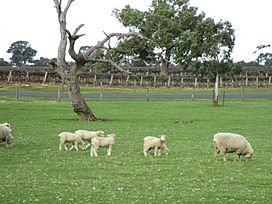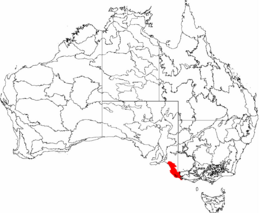Naracoorte woodlands facts for kids
Quick facts for kids Naracoorte woodlandsNaracoorte Coastal Plain |
|
|---|---|

Sheep and vines, Limestone Coast wine region
|
|

Map of the ecoregion
|
|
| Ecology | |
| Realm | Australasian |
| Biome | Mediterranean forests, woodlands, and scrub |
| Borders | Murray-Darling woodlands and mallee and Southeast Australia temperate forests |
| Geography | |
| Area | 24,431 km2 (9,433 sq mi) |
| Country | Australia |
| States | South Australia and Victoria |
| Conservation | |
| Conservation status | Critical/endangered |
| Protected | 2,326 km² (10%) |
The Naracoorte woodlands are a special natural area in southern Australia. This region covers the Naracoorte coastal plain. You can find it in southeastern South Australia and southwestern Victoria. It's also known as the Naracoorte Coastal Plain IBRA region. Sadly, only about 10% of this area still has its original plants and trees. Most of the land has been changed for farming and raising animals.
Contents
Discovering the Naracoorte Woodlands
This ecoregion is mostly flat or gently rolling. It has many coastal sand dunes. You'll also find lakes and wetlands here. Some of these water bodies are salty, some are a bit salty (brackish), and others are fresh.
Many of the soils in this area are sandy. Other parts are made of a hard, white rock called calcrete. This rock is like a natural cement made from calcium carbonate. Because of this, the area is often called the Limestone Coast.
Where are the Naracoorte Woodlands?
To the southeast, the Naracoorte woodlands are next to the Southeast Australia temperate forests. The area around Mount Gambier is part of those forests. To the north and east, you'll find the Murray-Darling woodlands and mallee. The Murray River estuary, where the river meets the sea, forms the northern edge of the Naracoorte woodlands. The Great Australian Bight is to the south and west.
Climate and Weather in the Woodlands
The Naracoorte woodlands have a mild Mediterranean climate. This means they have warm, dry summers and cool, wet winters. The nearby ocean helps keep temperatures from getting too extreme.
Rainfall varies across the region. The wetter southern areas get about 850 mm of rain each year. The drier inland and northern parts receive less, around 400 mm annually.
Plants of the Naracoorte Woodlands
The original plants here included open sclerophyll forests. These forests have trees with hard, tough leaves that help them survive dry conditions. They grow in areas with more rain and good drainage. In drier spots, you'd find open woodlands and shrublands.
Low shrubland, also called heath, grew in sandy soils and stable sand dunes. In areas that get wet seasonally, you can see open woodlands of river red gum (Eucalyptus camaldulensis). The wettest places have swamps and wet meadows. These areas are home to tussock sedges like Gahnia.
Animals of the Naracoorte Woodlands
The many wetlands and coastal lakes in this region are very important. They provide a home for many water birds. Some birds live here all year, while others stop during their long migrations.
This ecoregion doesn't have many species found only here. However, it is a critical place for some endangered birds. The endangered orange-bellied parrot (Neophema chrysogaster) spends its winters in the coastal dunes and saltmarshes. The endangered swift parrot (Lathamus discolor) and regent honeyeater (Anthochaera phyrigia) used to live here. Sadly, most of them are gone now because their homes have been destroyed.
Protecting the Naracoorte Woodlands
A study in 2017 showed that about 2,326 square kilometers of the ecoregion are protected. This is about 10% of the total area. Most of these protected areas are small. They help save the important coastal dunes and wetlands.
Some of the larger protected areas include:
- Coorong National Park
- Messent Conservation Park
- Canunda National Park
- Mount Richmond National Park

